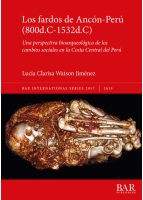Description
El objetivo principal de este libro es brindar una aproximación al modo de vida y muerte de la gente común de la bahía de Ancón, ubicada en la Costa Central del Perú, quiénes vivieron y murieron bajo el dominio del imperio Wari e Inca, como también bajo el grupo local autónomo Chancay (800-1532d.C). Para esta investigación se propuso una metodología multidisciplinaria que integra información desde las primeras excavaciones llevadas a cabo por Reiss y Stübel al final del siglo XIX, las excavaciones de Julio C.Tello a inicios del siglo XX, análisis de material de lo excavado por el Dr. Kauffman y reconstruciones 3D de fardos funerarios. Mediante el estudio del patrón funerario de las tumbas y fardos, como también de indicadores de salud encontrados en el esqueleto tales como marcas de actividad y nutricionales, entre otros se concluye que el imperio Wari y el grupo local Chancay impactó sobre la población de Ancón, no así durante el Imperio Inca.
The main goal of this book is to reconstruct the lifestyle and death of the dwellers of Ancon bay, located on the Central Coast of Peru. These people lived and died under Wari and Inca Imperial rule, as well as during the occupation of the site by a local autonomous group named Chancay (800-1532AD). For this investigation, a multidisciplinary methodology is proposed that combines information from the first excavations carried out by Reiss and Stübel at the end of the XIXth century, from excavations of Julio C. Tello at the beginning of the XXth century, with material analysis from Dr. Kauffman’s excavations and 3D reconstructions of funerary bundles. By studying both funerary patterns from tombs and bundles, as well as health indicators found on the skeletons such us activity and nutritional markers, among others, we concluded that the health of the people of Ancon was impacted strongly by the different occupations.
AUTHOR
Lucía Clarisa Watson Jiménez es Doctora en Antropología por UNAM. Sus investigaciones se enfocan en entender el modo de vida y muerte de las antiguas sociedades de los Andes Centrales desde la bioarqueología. Es asesora de cultura, docente universitaria, miembro del grupo HORUS y codirectora del proyecto bioarqueológico “Momias como microcosmos” del Dr. Andrew Nelson.
REVIEW
‘This is an important contribution on a famous, but poorly-published archaeological site. Ancon is known to all Andean archaeologists for its important historical contributions to early archaeological chronological schemes for Peru, as well as for its impressive funerary bundles. A comprehensive overview of materials excavated there over several centuries is most welcome.’ Professor John Verano, Tulane University
‘Both the synthesis of existing data and presentation of new data on mortuary bundle structure is new and of great value.’ Dr Ann H. Peters, University of Pennsylvania Museum of Archaeology and Anthropology











